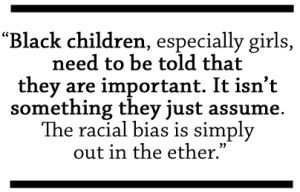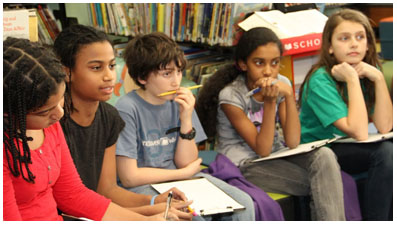
 Shana Mlawski is a native New Yorker who writes educational materials and tutors middle and high school students. She has written more than a hundred articles for the pop culture website OverthinkingIt.com, some of which have been featured in The Atlantic Monthly, The Guardian, The Huffington Post, and Ms. magazine. Her first novel, Hammer of Witches, was published by Tu Books in 2012.
Shana Mlawski is a native New Yorker who writes educational materials and tutors middle and high school students. She has written more than a hundred articles for the pop culture website OverthinkingIt.com, some of which have been featured in The Atlantic Monthly, The Guardian, The Huffington Post, and Ms. magazine. Her first novel, Hammer of Witches, was published by Tu Books in 2012.
Bring up FOX’s Sleepy Hollow and you’ll probably get one of two reactions. The first is, “OMG, guys: black people! On network television! And there’s a Hispanic guy! And John Cho! It’s almost like TV has finally entered the twenty-first century.”
The second, more common reaction goes thusly: “Wow. This show is COMPLETELY RIDICULOUS.”
Both reactions work for me. Sleepy Hollow does have an impressively diverse cast: of the eight major characters in its lineup, five are people of color (POC). More importantly, the main character is a woman of color.
As for the claim of ridiculousness… well, watch this:
[youtube=http://www.youtube.com/watch?v=IBOtvQcjnY8&w=560&h=315]
What’s most interesting to me is how the two reactions intersect. That Sleepy Hollow is racially diverse doesn’t make it unique. Want a show that isn’t all white people all the time? You can watch Scandal or Elementary. But Sleepy Hollow is something different, something rarely seen on mainstream television: a program with a non-white lead that is also a work of camp.
Camp Defined!
In her famous “Notes on Camp,” Susan Sontag defined the genre as “art that proposes itself seriously, but cannot be taken altogether seriously because it is ‘too much.’” Not a bad definition for a show that features a Headless Horseman carrying a machine gun. Sleepy Hollow takes itself seriously enough that it can quote Milton and Edmund Burke with a straight face, but its heroes also exclaim things like, “The answers are in George Washington’s Bible!” It may not be John Waters, but that sounds campy to me.
Continue reading →
 Andrea Cheng is the author of several critically-acclaimed books for young readers. Her most
Andrea Cheng is the author of several critically-acclaimed books for young readers. Her most ![]() recent novel, Etched in Clay, tells the story in verse of Dave the Potter, an enslaved man, poet, and master craftsperson whose jars (many of which are inscribed with his poetry and writings) are among the most sought-after pieces of Edgefield pottery. Etched in Clay recently won the Lee Bennett Hopkins Poetry Award.
recent novel, Etched in Clay, tells the story in verse of Dave the Potter, an enslaved man, poet, and master craftsperson whose jars (many of which are inscribed with his poetry and writings) are among the most sought-after pieces of Edgefield pottery. Etched in Clay recently won the Lee Bennett Hopkins Poetry Award.








 It started when my co-worker, Jamie Steinfeld, asked me to booktalk some realistic fiction for her sixth-grade Humanities class. A girl asked a question about Return To Sender—“Why is there a bird on the cover?”—and we were off. Good question! Yes, the hardcover does have a bird. And does anyone notice anything about the paperback? See how the boy has his face turned toward us, and we can see his blond hair, but the girl from Mexico has her back to us and we can’t tell what race she is? What’s up with that?
It started when my co-worker, Jamie Steinfeld, asked me to booktalk some realistic fiction for her sixth-grade Humanities class. A girl asked a question about Return To Sender—“Why is there a bird on the cover?”—and we were off. Good question! Yes, the hardcover does have a bird. And does anyone notice anything about the paperback? See how the boy has his face turned toward us, and we can see his blond hair, but the girl from Mexico has her back to us and we can’t tell what race she is? What’s up with that?